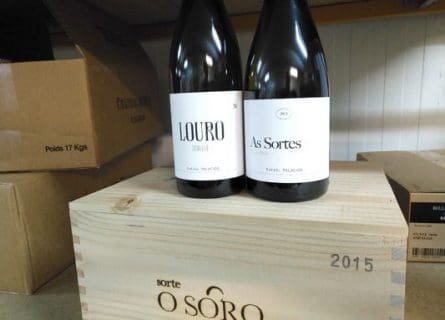Immerse yourself in Ponferrada's vibrant flavors and uncover hidden culinary gems with our expert insider guides. Plan an unforgettable trip today!
Read more
EXPLORE ALL OUR GALICIA WINE REGIONS GUIDE
Last updated: August 19, 2024
Valdeorras is a region that shocks and delights oenophiles in equal measure. After decades shrouded in obscurity (Valdeorras was once heavily planted with the totally unsuitable Palomino), the region is quickly earning a reputation as one of Spain’s most exciting places to search for quality white wine. Its star grape variety, Godello, produces full-bodied and complex whites occasionally compared to the best of Puligny-Montrachet by critics like Jancis Robinson MW – high praise indeed! Meanwhile, the small but growing volume of floral and crunchy Mencia reds has won over some of the world’s most influential sommeliers and wine buyers. Today, Valdeorras is the talk of the town. It may be smaller than Rias Baixas, but its international clout is equally potent.
Discover more about Spanish Wine

TGalicia always comes as a surprise to visitors accustomed to Spain’s hotter, drier southern areas. Indeed, aficionados of Andalucia may wonder if they’ve crossed the border into another universe! Nevertheless, this is Spain. It’s just a different piece of a complex and intricate puzzle; Galicia contains the smallest of Spain’s several production areas, and traditions here are Celtic and Christian with little Moorish influence. It is also home to one of Europe’s oldest languages: Gallego. The Celtic tribes who settled in these verdant hills spoke this ancient dialect and, for a time, won victory after victory in their battles against the hostile Roman invaders.
The Legend of St. James
Yet their resolve faded as the emperor Octavian poured significant resources into conquering northwestern Spain – he emerged triumphant during the Cantabrian Wars of the first century BC. The Romans founded several important settlements after Galicia was pacified, including Augusti (modern-day Lugo).
However, Galicia’s true history arguably began after the Western Roman Empire disintegrated in 476 AD. As the dust settled, many rival civilizations attempted to conquer the Iberian Peninsula, mainly to exploit its mineral wealth and fertile landscape. Among the more successful contenders were the Suebi, a Germanic tribe who settled in the region in the 5th century. They founded the Kingdom of Galicia, a political entity that endured until the 1800s.
But the Visigoths defeated the Suebi, who were, in turn, easily swept from power by the disciplined armies of Tariq.Following the Moorish invasion of 711, the Muslims took control of most of Spain and Portugal, giving rise to the sophisticated civilization known as ‘Al-Andalus.’
Yet the Moors never fully subjugated Galicia; it became part of the Kingdom of Castilla y Leon after the Christian monarchs expelled the Moors. According to historians, St James the Apostle preached in Galicia. He was executed in Palestine. Christians used the uncovering of his tomb in the 820s to boost morale and draw more mercenaries into their cause.
The 16th and 17th centuries were a time of relative stability for the citizens of Galicia despite numerous squabbles between rival nobles and their families. By the 1800s, a thriving winegrowing industry had developed in Galicia, but the arrival of the phylloxera louse, accidentally imported from the US, sadly curtailed this enterprise. Phylloxera devastated vineyards across Western Europe.
As a result of the regrafting program (the only defense against phylloxera), growers planted great swathes of Palomino Alicante Bouschet, producing fresh, light, but unremarkable wines. Thankfully, in the 1970s, local growers began experimenting with the almost forgotten native Godello variety, on which the region’s fame is primarily based.

Welcome to the “Valley of Gold.” Historians say this corner of the Ourense province may have been where the Romans planted the first grapes in Galicia. Yet wine production here remained a largely anonymous activity until recently. This damp, green corner of northwest Spain was traditionally very poor and virtually ignored by the rest of the country throughout the centuries. This and the region’s physical isolation meant that it was not until the late 1990s that the stupendous wines of Valdeorras found any market outside of Galicia and Spain.
Terroir of Valdeorras
Nevertheless, the landscape and terroir of Valdeorras are exceptional: vineyards line the slopes along the banks of the river Sil on well-drained, alluvial soils. Elsewhere, calcareous and granite/slate terroir dominate, producing some of the region’s most powerfully structured and aromatic Godello. The top climats (vineyard sites) enjoy a southeasterly aspect, cultivated on well-drained soils that climb to 700 meters above sea level. This offers an attractive combination of sufficient sunlight to ripen the berries, juxtaposed against cooler night-time temperatures and the resulting freshness and acidity in the wines; this is a common theme throughout Spain today.
However, this beautiful region stands apart from many vineyards in central and southern Spain; lush green pastures are punctuated by gently rolling hills, although this comes at the price of extremely high average rainfall! Indeed, the climate is typical of northern Spain: Atlantic-influenced, with inclement weather throughout the season and relatively mild summer temperatures.
Climatic Advantage
However, the Sil Valley’s microclimate also plays a vital role here, protecting vines from the worst excesses of the frequent oceanic storms. As a result, the valley enjoys higher average temperatures and less rain during the relatively short Galician summer, ensuring that Godello is usually fully ripened by harvest time during the fall.

It was Rafael Palacios (brother of Alvaro) who first advocated treating Godello as the equal of Chardonnay. Both his signature labels – As Sortes and Louro do Bolo – are stunning wines and an indictment of his (at the time) pioneering approach to the grape. If you’ve never tried these glorious whites, you must! They are complex and age-worthy wines that have few rivals in northwestern Spain.
Moreover, unlike the equally popular Albariño, which should generally be consumed soon after release, Godello’s Chardonnay-like structure responds well to barrel aging and cellaring. At its best, the grape offers powerful spicy and green fruit aromas, soft tropical fruit, and keen acidity. But that distinctive ‘cut’ of minerality truly sets Godello apart from the competition.
Thus, winemaking in Valdeorras, at least among the top estates, relies heavily on the latest equipment and a sophisticated approach to fermentation and maturation. First, it all starts in the vineyard: only the finest berries will be selected during the harvest and chilled to preserve freshness before they are gently pressed to release free-run juice. In the case of Louro de Bolo, this is then vinified in foudres (large oak vats) and left on its fine lees for several months before bottling.
Meanwhile, Sortes is fermented and matured in 500-liter oak barrels; Godello can benefit from a surprising degree of oak in the winemaking, although some growers prefer the reductive nature of stainless steel.
Global Recognition
Over the last few years, critical attention and praise from notaries such as Jancis Robinson have ensured that these wines have found a very willing clientele in discerning white drinkers worldwide. Growers can scarcely keep up with global demand; each year, the number of hectares under vine increases. But, of course, Valdeorras is not exclusively committed to Godello, although its commercial success as a region does reside with the variety. Small amounts of Palomino – the Sherry grape – remain, in addition to Spanish curiosities Valenciana and Lado. You are unlikely to see these fresh, grapey wines outside of Spain.
The reds, however, are a different matter – especially Mencia. Although it is a long way from attaining the fame of Godello, the grape’s sappy fruit and moderate alcohol have caught the attention of hipster somms in the US and northern Europe—a star beckons.
Forty-five years ago, Valdeorras existed in the shadows. Few critics or buyers took Spanish whites seriously; the nation was constantly pigeonholed as the land of Rioja, Cava, and Jerez. Of course, there was the odd exception here and there: Torres has been marketing a serviceable white called Viña Sol since the 1960s. But the idea of a thriving – and lucrative – industry dedicated to the export of premium white wines seemed like a fantasy in the mid-20th century.
High-Quality White Wines
And yet, here we are. A formerly poor and rural backwater has become one of Europe’s most important centers of high-quality white styles, ranging from the saline fruit of a good Albariño to the ripe and textured finesse of barrel-aged Godello from Valdeorras. Granted, the volumes cannot compete with certain New World regions and the behemoth that is Alsace, but Galicia has other tricks up its sleeve.
For example, it is one of the few European regions that can tempt sommeliers away from that ubiquitous creature called Kiwi Sauvignon Blanc. Indeed, if you glance at the best wine lists in New York, San Francisco, London, and Hong Kong, you’ll notice that Galician whites inevitably steal the show. This is because they offer an unbeatable combination of (relatively) good value, a generally high standard of winemaking, and a pleasing stylistic diversity that leaves Marlborough Sauvignon for dust.
So, today, there is no excuse for omitting Galician wines from your cellar. They will astound and delight you.
Savor the Essence of Albariño: Northwest Spain's Delightful White Grape for Seafood Pairings. Explore the Lightness and High Acidity of this Galician Gem.
Find out moreUnlock the secrets of Caíño Blanco grape, an intriguing Spanish variety. Delve into its characteristics and origins, and explore the wines it produces.
Find out moreDona Branca is a white grape variety from Portugal's Vinho Verde region. It offers delicate aromas of citrus, tropical fruits, and flowers. With a refreshing and balanced profile, Dona Branca wines are perfect for those seeking vibrant and unique flavors.
Discover Godello: Galicia's Exquisite White Wine Grape from Valdeorras. Unveiling the Delights of this Northwestern Spanish Varietal.
Find out moreExplore the captivating world of the Loureiro grape. Discover its aromatic charm, origins, and the remarkable wines it produces.
Find out moreLado is a lesser-known white grape native to the Iberian Peninsula. It offers a unique combination of fruity and floral aromas with bright acidity. Lado wines showcase flavors of green apple, pear, citrus, and subtle herbal notes. This refreshing and distinctive grape is gaining popularity among adventurous wine enthusiasts.
Palomino: The quintessential grape for Sherry in Andalucia, Spain's southern delight. Unearth tradition's essence in every sip.
Find out moreDiscover Torrontés grape: Captivating aromas, unique flavors. Argentina's shining star in wine production is also cultivated in Galicia, Spain. Floral, citrus, and herbal notes create a refreshing, medium-bodied white wine. Perfect with global cuisines. A sensory journey awaits.
Discover Treixadura grape: Origins, Flavor Profile, and Exceptional Wines—a must-read for wine enthusiasts seeking new taste sensations.
Find out moreDiscover the irresistible allure of Cabernet Sauvignon—a worldwide favorite with robust, dark-bodied flavor. Unleash your wine journey today!
Find out moreGarnacha: Spain's Red Gem. Akin to Pinot Noir, it bridges terroir and winemaking, crafting captivating expressions.
Find out moreUnearth Mencía: Spain's captivating red gem. Original and alluring, it emerges from the shadows, captivating wine enthusiasts worldwide.
Find out more
Immerse yourself in Ponferrada's vibrant flavors and uncover hidden culinary gems with our expert insider guides. Plan an unforgettable trip today!
Read more
Immerse yourself in Santiago de Compostela's vibrant flavors and uncover hidden culinary gems with our expert insider guides. Plan an unforgettable trip today!
Read moreIf you would like us to customize an exclusive luxury tour, contact us and let us know your travel plans. We offer luxury food and wine tours for private groups of a mininium two guests. In addition, all of our private, chauffeured tours are available year-round upon request.

